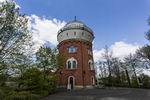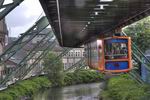Düsseldorf is the capital of North Rhine-Westphalia. This city is not often included in tourist routes and is not associated with classic Germany. This is not surprising, as it is located in the most industrial region of the country.

City center, Burgplatz ©Yuriy Buriak

Rhine panorama from the Duesseldorf waterfront ©Yuriy Buriak
Recently, Düsseldorf has become the cultural capital of Germany. The city holds a carnival and numerous major exhibitions. Eurovision contest was also held here.
Düsseldorf left extremely positive impression. Almost all tourists start their walk on the Royal Alley (Königsallee) that crosses all roads leading from the train station to the downtown. It is a luxury boulevard, formerly known as the Chestnut Alley. After an incident in 1848, when horse manure was thrown at King Friedrich Wilhelm IV, the street was renamed "Königsallee" :) At the end of the canal that runs in the middle of the alley is a very beautiful Triton fountain.

Koenigsallee in Duesseldorf ©Yuriy Buriak

Triton fountain at Koenigsallee in Duesseldorf ©Yuriy Buriak

Koenigsallee in Duesseldorf ©Yuriy Buriak
The Carsch-Haus building, built in the Art Nouveau style by architect Otto Engler, was demolished during the construction of the subway, and then restored with an offset of 23 m.

Musical fountain and Carsch-Haus building ©Yuriy Buriak
There's an old city, but small and not very old. You can get around the downtown (except the Media Harbor) in 60-90 minutes, which is quite convenient for tourists. Here you can find a house in which Heinrich Heine was born. But apart from this fact, the house itself is unremarkable. There are much more beautiful houses on the same street.

In this house writer and poet Heinrich Heine was born. ©Yuriy Buriak

House in the old city ©Yuriy Buriak

Barkas in the Old Harbor ©Yuriy Buriak

First tower office building in Duesseldorf, Wilhelm-Marx-Haus (1922-1924) ©Yuriy Buriak

St. Andrew's Church ©Yuriy Buriak

St. John's Church (Johanneskirche) ©Yuriy Buriak

Old city in Duesseldorf ©Yuriy Buriak
Market Square is the most beautiful place in the old city. On the Castle Square (Burgplatz) you can find two very interesting sculptures in addition to the tower. One of them, "Two Boys Turning Cartwheel", is a symbol of the city. However, the second sculptural composition, "Becoming a City", is more interesting. It symbolically represents the 700-year history of Düsseldorf.

Market Square in Duesseldorf ©Yuriy Buriak

Equestrian statue of Jan Wellem ©Yuriy Buriak

"Two Boys Turning Cartwheel", a fountain on Burgplatz ©Yuriy Buriak
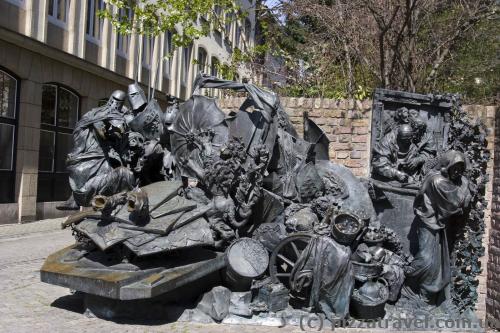
Sculptural group "Becoming a City" ©Yuriy Buriak

Sculptural group "Becoming a City" ©Yuriy Buriak

Sculptural group "Becoming a City" ©Yuriy Buriak

Sculptural group "Becoming a City" ©Yuriy Buriak
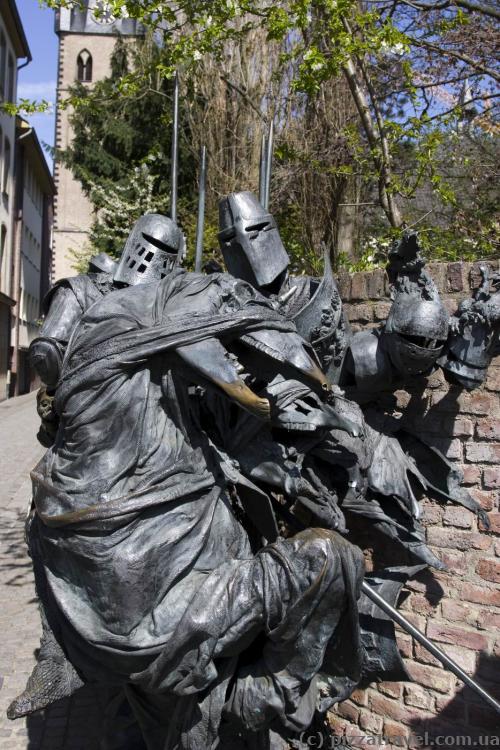
Sculptural group "Becoming a City" ©Yuriy Buriak

Sculptural group "Becoming a City" ©Yuriy Buriak
The Tower is the only surviving part of the XIII century Elector's Palace. The building itself was burned down in 1872.

Castle Tower in Duesseldorf ©Yuriy Buriak

Castle Tower in the old city of Duesseldorf ©Yuriy Buriak
We like cities with waterfronts, they are very picturesque. Düsseldorf waterfront is a tourist attraction. It's noticeable that a lot of labor was invested in its design and development. Note tiles in the form of waves. If you walk and look under your feet, the tiles will resemble water. A lot of chestnut trees are planted along the waterfront, creating a kind of a covered pavilion in summer and autumn.

Waterfront in Duesseldorf ©Yuriy Buriak

Maple trees are planted along the waterfront of Duesseldorf. ©Yuriy Buriak

On the waterfront in Duesseldorf ©Yuriy Buriak

Panorama of Duesseldorf from the old city ©Yuriy Buriak

Panorama of Duesseldorf from the Media Harbor ©Yuriy Buriak
TV Tower (Rhine Tower) is located almost in the center of the city. It is the architectural centerpiece of Düsseldorf. The tower will be present almost on every photo with river scenery. At the top of the tower you can find an observation deck and a revolving restaurant.

Rhine Tower in Duesseldorf ©Yuriy Buriak

Rhine Tower (Rheinturm) ©Yuriy Buriak

In the foreground there's an office building "City Gate". ©Yuriy Buriak

Duesseldorf view from the Rhine Tower ©Yuriy Buriak

Duesseldorf view from the Rhine Tower ©Yuriy Buriak

Unusual balconies in Duesseldorf ©Yuriy Buriak

Duesseldorf view from the Rhine Tower ©Yuriy Buriak

Just a few steps away from the downtown you can find a beach, although the water is not suitable for swimming. ©Yuriy Buriak

Vodafone Tower in Duesseldorf ©Yuriy Buriak

View from the Rhine Tower ©Yuriy Buriak
The city is located on the right bank of the Rhine, but on the left, among the meadows with sheep, there are several elite areas such as Oberkassel.

Rheinkniebruecke and Oberkasselerbruecke bridges ©Yuriy Buriak

There are sheeps on the other side of the river. ©Yuriy Buriak

Elite district Oberkassel in Duesseldorf ©Yuriy Buriak
However, the most interesting place in the city is the new area called Media Harbor. It is named after the TV tower that was built here in 1982. In the 1990s, the "modernist" buildings started to appear here. Be sure to walk across the disctrict. One of the most unusual houses is the one with colored men. This is an art project called Flossis from German artist Rosalie.

Media Harbor ©Yuriy Buriak

Media Harbor ©Yuriy Buriak

Houses in the Media Harbor ©Yuriy Buriak

Media Harbor (Medienhafen) ©Yuriy Buriak

Glass tower in the Media Harbor ©Yuriy Buriak

Unusual balcony in the Media Harbor ©Yuriy Buriak

Parliament House of North Rhine-Westphalia ©Yuriy Buriak

Yachts in the Media Harbor ©Yuriy Buriak

You can make such photo in the Media Harbor. ©Yuriy Buriak

"New Customs" architectural complex in the Media Harbor ©Yuriy Buriak

"New Customs" architectural complex in the Media Harbor ©Yuriy Buriak

"New Customs" architectural complex in the Media Harbor ©Yuriy Buriak

House in the Media Harbor ©Yuriy Buriak

House in the Media Harbor ©Yuriy Buriak

Flossis art project ©Yuriy Buriak

Flossis art project ©Yuriy Buriak

Flossis art project ©Yuriy Buriak
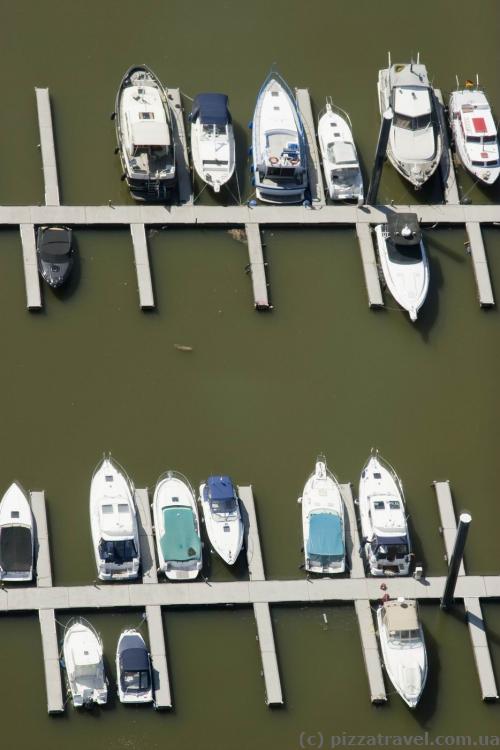
Yachts in the Media Harbor ©Yuriy Buriak

Colorium Tower in the Media Harbor ©Yuriy Buriak
More photos of Düsseldorf

Such monuments with different people can be found throughout the city. ©Yuriy Buriak

Such monuments with different people can be found throughout the city. ©Yuriy Buriak

Fountain in the Hofgarten Park ©Yuriy Buriak

Magnolias in the Hofgarten Park ©Yuriy Buriak

Hofgarten Park ©Yuriy Buriak

Installation "Colors in Everyday Life" in the Museum of Art ©Yuriy Buriak

"Boy Turning Cartwheel", symbol of Duesseldorf ©Yuriy Buriak

Free toilets on the city streets ©Yuriy Buriak

Sculpture in the Hofgarten Park ©Yuriy Buriak

"Playing Ball" sculpture in Duesseldorf ©Yuriy Buriak

Long plastic benches in Duesseldorf ©Yuriy Buriak
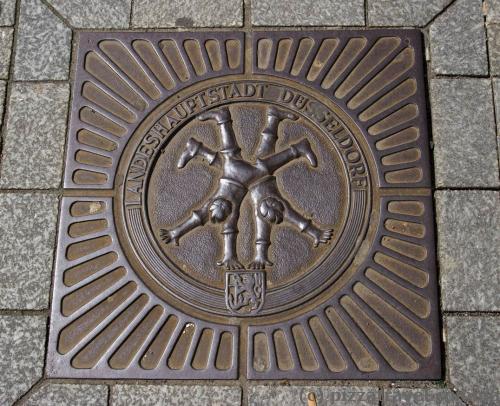
Symbols of the city everywhere ©Yuriy Buriak

Rheinkniebruecke ©Yuriy Buriak

Rheinkniebruecke and Oberkasselerbruecke bridges ©Yuriy Buriak

Installations in the Burgerpark ©Yuriy Buriak

Tourist route in Duesseldorf ©Yuriy Buriak
2015This time we walked through the park Hofgarten, where benches of the lamps were installed.

Park Hofgarten in Dusseldorf ©Yuriy Buriak
Visited the Jägerhof Palace, which houses the Goethe Museum. In 1811 Napoleon stayed here for 4 days.

©Yuriy Buriak

©Yuriy Buriak
And watched a sculpture near the museum of Regional Development NRW Forum.

©Yuriy Buriak
Getting there: Düsseldorf airport is an international hub and the third largest airport in Germany. It is easy to get to the city by other transport, we came by train.



















































































